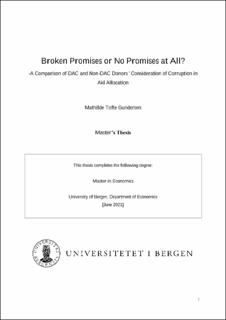Broken Promises or No Promises at All? -A Comparison of DAC and Non-DAC Donors’ Consideration of Corruption in Aid Allocation
Master thesis
Permanent lenke
https://hdl.handle.net/11250/2767649Utgivelsesdato
2021-06-15Metadata
Vis full innførselSamlinger
- Master theses [118]
Sammendrag
Foreign aid is more likely to be effective in countries with quality institutions and low levels of corruption. Therefore, the OECD Development Assistance Group (DAC) made it their official goal to be more selective in their aid allocation, based on recipients’ needs and institutional quality. On the other hand, aid donors that are not members of DAC have been criticised for not exhibiting the same level of selectivity that DAC donors claim to work towards. Using the statistical programme Stata/SE 16.0, I evaluate whether DAC donors meet their selectivity criteria with regards to corruption, and if donors’ self-interest distort aid allocations of DAC and non-DAC donors differently. In a twofold analysis, I apply the empirical strategies of ordinary least squares (OLS) and pseudo poisson maximum likelihood (PPML) in order to determine whether corrupt countries receive more or less foreign aid, and how donors differ in their aid allocation. I find that more foreign aid is allocated to more corrupt countries overall. However, donors allocate their aid highly heterogeneously, even within groups that should follow the same allocation rules. There are donors both within and outside of DAC that gives more aid to more corrupt countries. Most donors are concerned with self-interest to some extent, but with different priorities.
